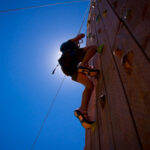Slacklining is a relatively new extreme sport. Many individuals refer to it as “moving meditation.” In a sense, slacklining is similar to tight rope walking. Many individuals like to do this activity in the woods. This is because they can find trees to use that are strong and close together. It also can provide some challenges. You can slackline over a stream, set of down trees, and ravines.
Slacklining is used as a lead up balancing activity for extreme sports like climbing, snowboarding, surfing, skiing and even gymnastics. However, many amateurs use it for entertainment and confidence building in themselves. Slacklining combines balance, movement and concentration. It is the skill of walking on nylon webbing. The sport first began in the late 1970’s. It actually started in Yosemite Valley. A parking lot chain was first used. Climbing enthusiasts moved it from that to nylon webbing.
A starting kit consists of 75 feet of tubular nylon webbing, 35 feet of static rope, 1 slackline tightening system and two line lockers. You can find a kit for a cost of about $230 at Slackline Brothers.
Slackline competitions are springing up at many climbing events. A persons top three tricks are scored. There are countless tricks to be used and more are being added all the time.These freestyle medley rules are followed. Note: (These rules were pasted from their scoring sheet.)
All equipment must be approved in advance.
No alcoholic beverages are allowed on the slackline; Anyone under the influence of alcohol will be disqualified
All competitors must fill out a waiver; Anyone under the age of 18 must have a parent sign in person
Time limit is 2 minutes; If the competitor falls they may begin where they left off or from the start of the routine, time limit permitting
Any member of Slackline Brothers, Inc., or any judge may disqualify a competitor if they feel he/she is unnecessarily endangering themselves, other competitors, or bystanders
The use of props i.e. juggling clubs/balls, magazines, etc is allowed but must be approved by a judge
Line length and height are determined before competition by the judging staff with the input of the competitors
Line tension is adjustable; Any competitor may ask to have the line tightened or loosened for their performance; All feasible requests will be met at the discretion of the head judge or another appointed official
Time begins when a competitor steps off the ground, or in the case of a high-line steps from the end; Undue hesitation to start will result in an appropriate time penalty
Spotters are allowed but null any trick where they make contact with the competitor for any reason
Available padding may be arranged as the competitor sees fit as long as it doesn’t restrict line movement or change the nature of the tricks.
Many individuals start out by using two trees in their backyard. They set up their slack line close to the ground to avoid injury. As they get better, they move it up or to different locations. From there, they advance to fun and competitions. Maybe slacklining is in your future.



